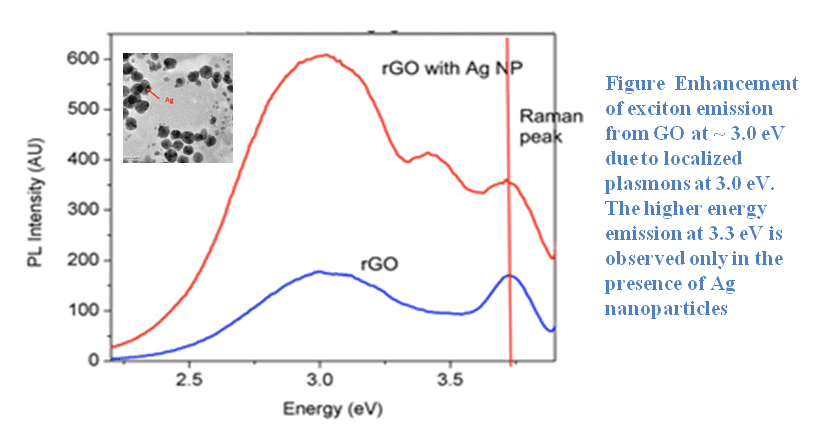
Gap Plasmon Enhanced Excitonic Emission from Graphene Oxide Quantum Dots
 Graphene oxide (GO) based nanostructures exhibit unique optical characteristics. The optical properties can be influenced not only by the route of material synthesis but also by its fundamental physical characteristics such as strong exciton binding energy and molecular orbital configuration. GO has strong exciton binding energy for transitions between σ and π orbital ranging from 390 meV-500 meV. It results in strong optical nonlinearities and quantum confined effects in the sp2 clusters synthesized during the reduction of graphene oxide. Recently we have demonstrated the modification of spontaneous emission from GO quantum dots (GO-QD) in the presence of surface plasmons which results in the enhancement of broadband light emission in the visible wavelength region. [1] The emission intensity from GO-QD is relatively weak compared to other colloidal quantum dots. Our objective is to increase the luminescence and Raman scattering efficiency using localized surface plasmon interaction for potential application in light emitters and bio-molecular sensing. The emission bandgap of reduced GO quantum confined structures can be tuned by controlling the size of sp2 clusters within sp3 clusters. We have studied the effect of localized plasmon coupling with the excitons for studying plasmon - exciton interactions in the strong coupling regime. The localized plasmons due to silver nanoparticles were tuned to the emission wavelength of the GO quantum dots. For the appropriate concentration of plasmons and excitons, a strong enhancement of the emission from the quantum dots (QDs) were observed. However the generation of high energy PL emission from GO QDs is also observed, which is presumably due to the occurrence of the high energy plasmon modes due to the gap plasmons formed by the Ag nanoparticles. The silver nanoparticles traps GO quantum dots within the nanogaps due to electrostatic surface charges. Its results in strong coupling of the anti-symmetric mode of the gap plasmons to the smaller sp2 clusters. Surface enhanced Raman scattering is also observed from the graphene oxide system due to localized plasmon fields.
Graphene oxide (GO) based nanostructures exhibit unique optical characteristics. The optical properties can be influenced not only by the route of material synthesis but also by its fundamental physical characteristics such as strong exciton binding energy and molecular orbital configuration. GO has strong exciton binding energy for transitions between σ and π orbital ranging from 390 meV-500 meV. It results in strong optical nonlinearities and quantum confined effects in the sp2 clusters synthesized during the reduction of graphene oxide. Recently we have demonstrated the modification of spontaneous emission from GO quantum dots (GO-QD) in the presence of surface plasmons which results in the enhancement of broadband light emission in the visible wavelength region. [1] The emission intensity from GO-QD is relatively weak compared to other colloidal quantum dots. Our objective is to increase the luminescence and Raman scattering efficiency using localized surface plasmon interaction for potential application in light emitters and bio-molecular sensing. The emission bandgap of reduced GO quantum confined structures can be tuned by controlling the size of sp2 clusters within sp3 clusters. We have studied the effect of localized plasmon coupling with the excitons for studying plasmon - exciton interactions in the strong coupling regime. The localized plasmons due to silver nanoparticles were tuned to the emission wavelength of the GO quantum dots. For the appropriate concentration of plasmons and excitons, a strong enhancement of the emission from the quantum dots (QDs) were observed. However the generation of high energy PL emission from GO QDs is also observed, which is presumably due to the occurrence of the high energy plasmon modes due to the gap plasmons formed by the Ag nanoparticles. The silver nanoparticles traps GO quantum dots within the nanogaps due to electrostatic surface charges. Its results in strong coupling of the anti-symmetric mode of the gap plasmons to the smaller sp2 clusters. Surface enhanced Raman scattering is also observed from the graphene oxide system due to localized plasmon fields.
arup@unt.edu
Powered by Eventact EMS